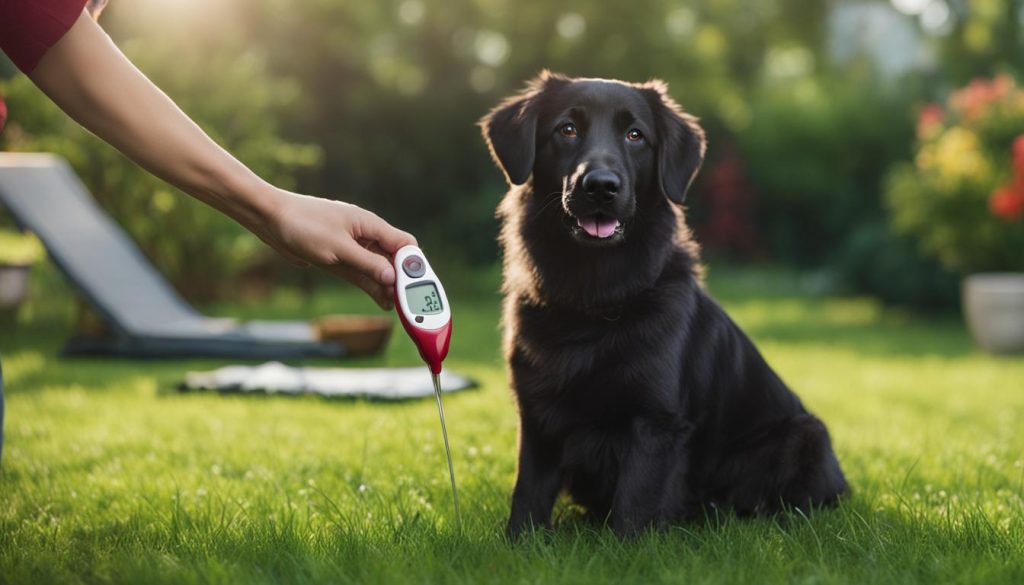As a dog owner, you may have noticed that your furry friend’s head feels hot to the touch. This phenomenon can be concerning, but it’s essential to understand the various reasons behind a hot dog head to ensure your pet’s well-being.
There can be several explanations for why your dog’s head feels warm. Fever, stress, dehydration, infections, allergies, and inflammation are common culprits. Recognizing these causes is crucial for addressing any potential health issues your dog may be experiencing.
Key Takeaways:
- A hot dog head can indicate various underlying issues such as fever, dehydration, or infections.
- Stress and allergies can also contribute to an elevated head temperature in dogs.
- Checking your dog’s temperature using a dog thermometer can help determine if they have a fever.
- If your dog exhibits additional symptoms along with a hot head, it’s essential to consult a veterinarian for proper diagnosis and treatment.
- Preventive measures, such as keeping your dog properly hydrated and monitoring their activity levels, can help prevent a hot dog head.
5 Reasons Your Dog’s Head Feels Hot to the Touch

There are several reasons why a dog’s head may feel hotter than the rest of their body. These include:
- Fever: A hot dog head can be a sign of an underlying infection or illness, as the body’s temperature rises in response to an immune response.
- Stress: Just like in humans, stress can also cause a dog’s body temperature to increase, leading to a hot head.
- Vaccinations: Some dogs may experience a mild increase in temperature after receiving vaccinations, which can contribute to a hotter head.
- Allergies: Allergic reactions in dogs can sometimes manifest as a fever, resulting in a hot head.
- Inflammation: Inflammation in the head or body can cause localized heat and make the dog’s head feel hot to the touch.
In these cases, it’s important to monitor your dog’s temperature and seek veterinary care if necessary. By addressing the underlying cause, you can help alleviate your dog’s discomfort and restore their overall well-being.
| Cause | Description |
|---|---|
| Fever | A sign of infection or illness, causing the body temperature to rise and resulting in a hot dog head. |
| Stress | Increased body temperature due to stress can contribute to a hot head in dogs. |
| Vaccinations | Some dogs may experience a mild temperature increase after receiving vaccinations, leading to a hotter head. |
| Allergies | Allergic reactions can trigger a fever, causing the dog’s head to feel hot. |
| Inflammation | Localized inflammation, whether from an injury or a condition, can result in a hot dog head. |
How to Check Your Dog’s Temperature

To determine if your dog has a fever, you can use a dog thermometer to check their temperature. The most common types of dog thermometers are digital ear thermometers, digital rectal thermometers, and mercury rectal thermometers. Digital ear thermometers are the easiest and most comfortable to use, but they may not be as accurate as rectal thermometers. When using a rectal thermometer, it’s essential to make the experience as comfortable as possible for your dog and follow the instructions provided with the thermometer.
Checking your dog’s temperature is an important part of monitoring their health, especially if you suspect they may have a hot head. Here’s a step-by-step guide on how to check your dog’s temperature:
- Prepare the thermometer: Ensure that you have a clean and properly functioning thermometer. If you are using a digital thermometer, make sure it is turned on and set to the appropriate mode.
- Choose the method of measurement: Decide whether you will use a digital ear thermometer or a rectal thermometer. Digital ear thermometers are less invasive and easier to use, while rectal thermometers provide more accurate readings.
- Get your dog into a comfortable position: Find a quiet and calm area where your dog can relax. Gently restrain your dog, if necessary, to prevent them from moving during the temperature check.
- For digital ear thermometers: Gently lift your dog’s ear and insert the thermometer probe into the ear canal. Follow the manufacturer’s instructions for the recommended insertion depth and hold the thermometer in place until you hear a beep or see a temperature reading on the display. Remove the thermometer and check the temperature reading.
- For rectal thermometers: Lubricate the thermometer with water-based lubricant or petroleum jelly. Lift your dog’s tail and gently insert the thermometer into the rectum, about 1 inch for small dogs and 2 inches for larger dogs. Hold the thermometer in place for about one minute or until you hear a beep or see a temperature reading on the display. Remove the thermometer and check the temperature reading.
- Record the temperature: Note down the temperature reading and the time of measurement. Keep track of any changes or patterns in your dog’s temperature for future reference.
Remember, checking your dog’s temperature should be done with care and patience. If you are unsure about how to use a dog thermometer or have concerns about your dog’s health, it’s always best to consult with a veterinarian.
Common Causes of a Hot Dog Head

There are various reasons why a dog may have a hot head. These include:
- Fever: Fever can indicate an underlying infection or illness in dogs.
- Heatstroke or overheating: Dogs can experience a hot head when exposed to high temperatures for an extended period.
- Dehydration: A lack of proper hydration can cause an increase in a dog’s body temperature.
- Infectious diseases: Diseases such as distemper or kennel cough can lead to a hot dog head.
- Allergies: Inflammation and fever can be triggered by allergies in dogs.
- Skin and ear infections: Infections in the skin or ears can cause localized inflammation, raising the temperature of the head.
- Autoimmune disorders: Dogs with autoimmune disorders can experience inflammation and an increase in body temperature.
- Injury to the head or neck: Trauma to the head or neck can result in a hot dog head.
Understanding the causes of a hot dog head is important in determining the underlying issue and seeking appropriate veterinary care.
Recognizing Symptoms of a Hot Dog Head

In addition to a hot head, there are other symptoms that may indicate an issue with your dog’s health. It’s important to pay attention to these signs and seek veterinary care if necessary.
- Excessive panting
- Red or flushed ears and gums
- Drooling
- Lethargy
- Vomiting or diarrhea
- Changes in behavior
These symptoms can be indicative of various underlying health issues, and a hot head may be one of the signs. If you notice any of these symptoms in your dog, it’s important to consult with a veterinarian. They will be able to assess your dog’s condition, perform any necessary tests, and provide the appropriate treatment.
Example Table:
| Symptom | Possible Causes |
|---|---|
| Excessive panting | Heatstroke, stress, fever |
| Red or flushed ears and gums | Inflammation, fever |
| Drooling | Dehydration, nausea, oral health issues |
| Lethargy | Illness, pain, fatigue |
| Vomiting or diarrhea | Gastrointestinal issues, infection, dietary issues |
| Changes in behavior | Pain, anxiety, discomfort |
Diagnosing and Treating a Hot Dog Head

A hot dog head can be diagnosed through a physical examination by a veterinarian, including checking the dog’s temperature, heart rate, and respiratory rate. Blood tests and imaging may also be used to identify any underlying medical conditions. Treatment will depend on the underlying cause, and it may include medications or home remedies such as providing a cool and comfortable living space and offering plenty of water.
| Diagnosing a Hot Dog Head | Treating a Hot Dog Head | Veterinary Care for a Hot Dog Head |
|---|---|---|
| – Physical examination by a veterinarian | – Medications | – Veterinary diagnosis |
| – Checking temperature, heart rate, and respiratory rate | – Home remedies | – Blood tests |
| – Blood tests and imaging | – Providing a cool and comfortable living space | – Imaging |
When diagnosing a hot dog head, a veterinarian will conduct a thorough physical examination, which includes checking the dog’s body temperature, heart rate, and respiratory rate. Additionally, blood tests and imaging may be used to further evaluate the dog’s condition and identify any underlying medical issues contributing to the hot dog head. It is essential to obtain a proper diagnosis to determine the appropriate course of treatment.
Treatment for a hot dog head will vary depending on the underlying cause. In some cases, medications may be prescribed to address infections, inflammation, or other specific conditions contributing to the hot head. Alternatively, home remedies such as providing a cool and comfortable living space, ensuring proper hydration, and offering plenty of water may also be recommended to alleviate symptoms and promote overall comfort.
Seeking veterinary care is crucial when dealing with a hot dog head. A veterinarian will be able to provide an accurate diagnosis based on thorough examination and appropriate testing. They can then recommend the most suitable treatment options for the specific situation, ensuring the best possible care for your dog’s hot head.
Preventing a Hot Dog Head
When it comes to keeping your dog healthy and comfortable, prevention is key. By taking appropriate measures, you can help prevent a hot dog head and ensure your furry friend’s well-being. Here are some essential steps to follow:
- Provide a comfortable living space: Create a cool and shaded area for your dog to retreat to on hot days. Make sure they have access to fresh air and avoid leaving them in enclosed spaces that can trap heat.
- Avoid excessive exposure to heat: Limit your dog’s time outdoors during the hottest parts of the day, especially in the peak summer months. Take them for walks in the early morning or late evening when it’s cooler.
- Keep your dog properly hydrated: Always provide plenty of fresh water for your dog to drink. Make sure they have access to water both indoors and outdoors, and refill their bowl regularly to ensure it’s clean and full.
- Monitor their activity levels: Avoid engaging in vigorous exercise or play sessions during hot weather. Dogs can easily overheat, so it’s important to adjust their activity level accordingly.
- Seek medical attention for underlying health issues: If your dog has any existing health conditions that may contribute to a hot dog head, consult with your veterinarian on how to manage and prevent overheating.
By implementing these preventive measures, you can minimize the risk of your dog experiencing a hot dog head and ensure they stay cool, hydrated, and healthy.
Should You Be Concerned About a Hot Dog Head?

While a hot dog head may be normal in some cases, it’s important to be aware of any changes in your dog’s behavior or health. If your dog exhibits symptoms such as excessive panting, lethargy, vomiting, or changes in appetite along with a hot head, it’s crucial to seek veterinary care. The vet will be able to assess the situation and provide appropriate guidance and treatment.
It’s natural to feel concerned when your dog’s head feels hotter than usual. However, determining whether it’s a cause for worry depends on the accompanying symptoms and overall behavior of your furry friend. In some cases, a hot dog head may be a temporary response to external factors such as exercise or hot weather.
However, if your dog’s head feels hot and they are displaying other concerning symptoms, it’s important to consult a veterinarian. Excessive panting, lethargy, vomiting, or changes in appetite can indicate an underlying health issue that requires medical attention. Additionally, if your dog’s hot head persists for an extended period without any apparent explanation, it’s best to seek professional advice.
A veterinarian is equipped with the knowledge and expertise to properly assess your dog’s health and provide appropriate treatment. They may perform a physical examination, conduct diagnostic tests, and recommend further steps based on the findings. Remember, early intervention can prevent potential complications and ensure your dog’s well-being.
Wrapping Up
Understanding why your dog’s head may feel hot is crucial for their overall health and well-being. By actively monitoring their temperature, seeking veterinary care when necessary, and taking preventive measures, you can ensure that your dog remains comfortable and healthy. If you have any concerns or questions about your dog’s hot head, it is always advisable to consult with a veterinarian.
Recognizing the causes of a hot dog head, such as fever, stress, dehydration, infections, allergies, and inflammation, allows you to take appropriate action to address the underlying issue. Whether it’s providing a cool and comfortable living environment, ensuring proper hydration, or administering medications as advised by a vet, each step you take contributes to your dog’s well-being.
Ultimately, your dog relies on you to care for their health. By being proactive and attentive to any changes in behavior or symptoms accompanying a hot head, you can help identify and address any underlying medical conditions promptly. Prioritizing your dog’s health and seeking veterinary care as needed will ensure they live a happy and comfortable life.
FAQ
Why does my dog’s head feel hot?
There are several reasons why a dog’s head may feel hot, including fever, stress, dehydration, infections, allergies, and inflammation.
How can I check my dog’s temperature?
You can use a dog thermometer to check your dog’s temperature. The most common types of dog thermometers are digital ear thermometers, digital rectal thermometers, and mercury rectal thermometers.
What are the common causes of a hot dog head?
The common causes of a hot dog head include fever, heatstroke, dehydration, infectious diseases, allergies, skin and ear infections, autoimmune disorders, and head or neck injuries.
What are the symptoms of a hot dog head?
Symptoms of a hot dog head may include excessive panting, red or flushed ears and gums, drooling, lethargy, vomiting or diarrhea, and changes in behavior.
How is a hot dog head diagnosed and treated?
A hot dog head can be diagnosed through a physical examination by a veterinarian, including checking the dog’s temperature, heart rate, and respiratory rate. Treatment will depend on the underlying cause and may include medications or home remedies.
How can I prevent a hot dog head?
Preventing a hot dog head involves providing a comfortable living space, avoiding excessive heat exposure, keeping your dog hydrated, monitoring their activity levels, and seeking medical attention for any underlying health issues.
Should I be concerned about a hot dog head?
If your dog exhibits symptoms such as excessive panting, lethargy, vomiting, or changes in appetite along with a hot head, it’s crucial to seek veterinary care to assess the situation.






